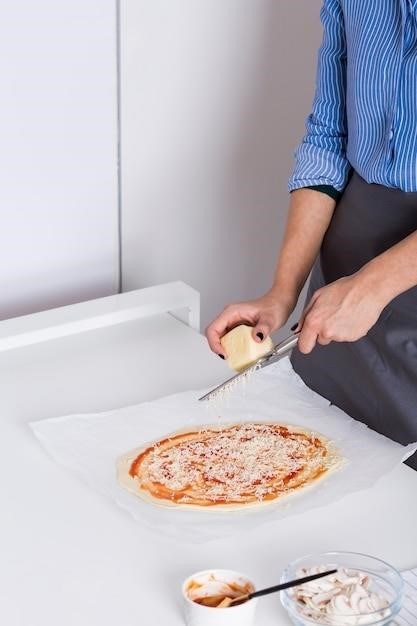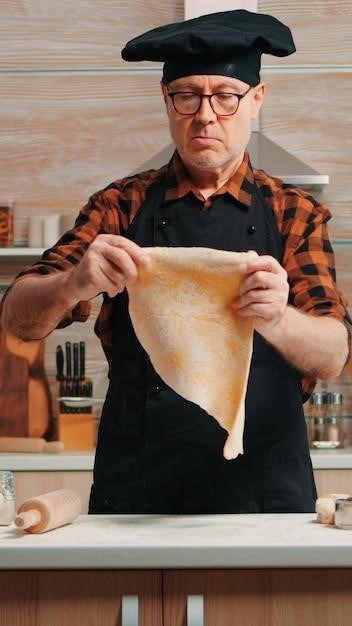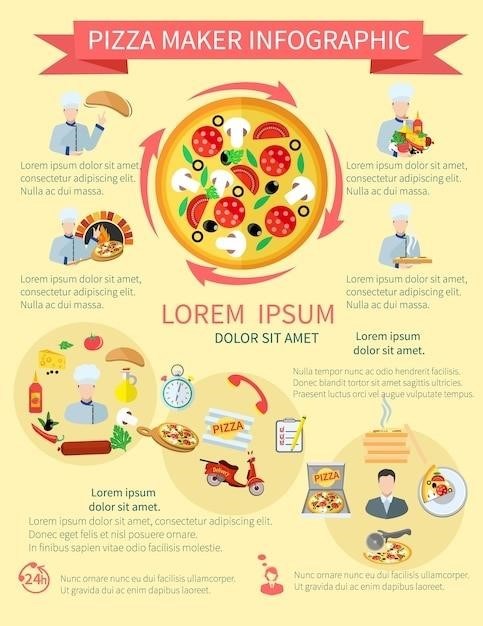joe corbi pizza cooking instructions

Joe Corbi Pizza⁚ A Comprehensive Cooking Guide
This guide provides comprehensive instructions for cooking Joe Corbi pizzas. It covers preheating your oven to the optimal temperature range of 375°F to 450°F, proper placement on the middle rack, and baking times ranging from 5 to 7 minutes, ensuring a perfectly melted cheese and baked crust. Consult the instructions for your specific pizza kit for detailed baking time and temperature.
Understanding Joe Corbi Pizza Kits
Joe Corbi pizza kits offer a convenient and delicious way to enjoy pizza at home. These kits typically include a pre-made pizza crust, pizza sauce, and cheese. Some varieties also include pre-sliced toppings like pepperoni or vegetables. The crusts are often described as a “honeycomb” style, contributing to a unique texture. Kits are available in various sizes, perfect for individuals or larger gatherings. Before beginning, carefully check the packaging for any specific instructions or allergen warnings, as ingredients may vary depending on the type of pizza kit. Note that oven temperatures and baking times might need adjusting based on your oven’s characteristics.
Remember to always preheat your oven according to the instructions on the package, typically ranging from 375°F to 450°F. Proper preparation ensures a consistently enjoyable pizza experience. The convenience of these kits makes them a popular choice for fundraising events and home cooking alike. Enjoy the ease and delicious results of a Joe Corbi pizza!
Variety of Joe Corbi Pizza Options
Joe Corbi offers a diverse range of pizza kits to satisfy various tastes and preferences. Beyond the classic cheese pizza, numerous topping combinations are available, catering to both simple and adventurous palates. Popular choices often include pepperoni, a crowd-pleasing favorite; various vegetable options for a healthier choice; and even specialty pizzas featuring unique ingredient blends. The availability of specific options might vary depending on the retailer or fundraiser. Check your local supplier or online store for the most up-to-date selection.
Consider factors like dietary restrictions when making your selection. While many options are available, always confirm the ingredients listed on the packaging to ensure they meet your needs. Whether you prefer a simple cheese pizza or a more elaborate creation, Joe Corbi provides a kit to match your desires. The variety ensures there’s a perfect pizza for everyone to enjoy.
Preheating Your Oven for Optimal Results
Proper oven preheating is crucial for achieving the perfect Joe Corbi pizza. The recommended temperature range varies slightly depending on the specific pizza kit and your oven, but generally falls between 375°F and 450°F. Always check the instructions printed on your individual pizza box for the precise temperature recommendation. Preheating allows the oven to reach the necessary temperature for even cooking, ensuring the crust achieves a desirable crispness while the cheese melts perfectly.
Insufficient preheating can lead to uneven cooking, a soggy crust, or undercooked cheese. Allow your oven to preheat for at least 10-15 minutes before placing the pizza inside. Use an oven thermometer to verify the temperature accuracy if you have concerns about your oven’s calibration. This simple step significantly impacts the final outcome, guaranteeing a delicious and satisfying pizza experience every time.

Detailed Cooking Instructions
Follow these steps for perfectly baked Joe Corbi pizza⁚ preheat your oven, place the pizza on the middle rack, and bake according to the time and temperature specified on the box for optimal results.
Placement of the Pizza in the Oven
Correct placement of your Joe Corbi pizza within the oven is crucial for even cooking and a delicious final product. Avoid placing the pizza too close to the heating element, as this can lead to burning. Similarly, positioning it too low in the oven may result in uneven baking. The ideal placement is in the center of the oven, on the middle rack. This ensures that the heat is distributed evenly across the pizza, resulting in a perfectly cooked crust and melted cheese. If your oven tends to cook unevenly, you might experiment with slightly adjusting the rack position. For particularly thick crusts or pizzas, using a baking sheet can help to prevent overcooking of the bottom crust while allowing the top to brown nicely. Remember, consistent monitoring is key to avoiding any unpleasant surprises! Always refer to your specific Joe Corbi pizza kit instructions for any recommendations regarding placement, as this can vary depending on the type of pizza and oven.
Baking Time and Temperature Variations
Achieving perfectly baked Joe Corbi pizza requires attention to both time and temperature. While general guidelines suggest preheating your oven to between 375°F and 425°F and baking for 5 to 7 minutes, individual ovens can vary significantly. Factors such as oven age, type, and even the ambient room temperature can affect cooking time. Always begin by preheating your oven thoroughly to the recommended temperature range. For thinner crust pizzas, a slightly lower temperature and shorter baking time might be ideal to prevent burning. Conversely, thicker crusts might require a higher temperature and longer baking duration to ensure complete cooking. Closely monitor your pizza during the baking process. The cheese should be completely melted and bubbly, and the crust should be golden brown and cooked through. If the crust appears to be browning too quickly, consider reducing the oven temperature slightly or using a baking sheet to protect the bottom. Don’t hesitate to adjust baking times based on your oven’s performance and your desired level of doneness.
Checking for Doneness⁚ Melted Cheese and Baked Crust
Determining when your Joe Corbi pizza is perfectly baked involves a visual check of both the cheese and the crust. The cheese should be completely melted and bubbly, exhibiting a slightly browned appearance in places. Avoid undercooking, as this can result in a gummy or unappetizing texture. However, overcooking will lead to a burnt crust and potentially dry cheese. Look for a consistent melt across the entire pizza surface; any pockets of unmelted cheese indicate the need for additional baking time. Regarding the crust, aim for a golden-brown color. The edges should be slightly crisp and firm to the touch, demonstrating a complete bake. If the crust appears pale or doughy, return the pizza to the oven for a few more minutes. Conversely, if the crust is excessively dark or burnt, reduce the oven temperature or baking time for future attempts. Remember that oven temperatures vary, so these are guidelines; adjust based on your specific oven’s characteristics. A perfectly baked Joe Corbi pizza presents a visually appealing combination of melted, bubbly cheese atop a golden-brown, crisp crust.
Troubleshooting Common Issues
This section addresses common problems encountered while baking Joe Corbi pizzas, offering solutions for overcooked, undercooked, or unevenly cooked results. Proper oven temperature and baking time are key to success.
Overcooked Crust⁚ Prevention and Solutions
An overcooked crust is a common issue when baking frozen pizzas, including Joe Corbi pizzas. The key to preventing this is careful monitoring of baking time and temperature. The recommended range is 375°F to 425°F, but ovens vary, so start with the lower end of the range. Overbaking can lead to a hard, dry, and potentially burnt crust. To prevent an overcooked crust, closely watch the pizza during the last few minutes of baking. If the edges appear to be browning too quickly, consider reducing the oven temperature slightly or loosely covering the edges with aluminum foil. Always check for doneness by looking for a golden-brown crust and fully melted cheese. If you accidentally overcook your pizza, there are a few things you can do to salvage it. While a completely burnt crust is unsalvageable, a slightly overcooked crust can sometimes be improved by adding a touch of moisture. You can try lightly brushing the crust with a little olive oil or even a sprinkle of water, and reheating briefly. However, this may not fully restore the original texture. Prevention is always the best approach; sticking to the recommended temperature and time, and closely monitoring the baking process, will help you achieve a perfectly cooked pizza every time.
Undercooked Crust⁚ Adjusting Baking Time and Temperature
An undercooked Joe Corbi pizza crust is characterized by a doughy or gummy texture. This often happens when the baking time or temperature is insufficient. The recommended baking temperature is between 375°F and 425°F, but your oven’s actual temperature may differ. If your pizza’s crust is undercooked after the recommended 5-7 minutes, there are several adjustments you can make. First, ensure your oven is preheated to the correct temperature using an oven thermometer for accuracy. Second, increase the oven temperature by 10-20 degrees, and monitor carefully. Third, extend the baking time in small increments, such as 1-2 minutes at a time, checking frequently for doneness. The crust should be golden brown and firm to the touch, not soft or pliable. Avoid dramatically increasing the baking time, as this can lead to a burnt crust. If the cheese is melted but the crust remains undercooked, consider using a baking sheet instead of baking directly on the oven rack; this can help distribute heat more evenly. Finally, remember that ovens vary; your next Joe Corbi pizza might require slightly different baking parameters depending on your specific oven.
Unevenly Cooked Pizza⁚ Oven Placement and Rotation
An unevenly cooked Joe Corbi pizza, with some areas burnt and others undercooked, often points to issues with oven temperature distribution or pizza placement. To prevent this, always preheat your oven thoroughly to the recommended temperature (375°F to 425°F) before placing the pizza. Use an oven thermometer to ensure accuracy. Position the pizza on the middle rack of the oven for even heat distribution from the top and bottom elements. Avoid placing it too high or too low, as this can lead to uneven cooking. If your oven has hot spots, rotate the pizza halfway through the baking time. This ensures that all parts of the pizza receive equal exposure to the heat. Careful observation is key; if one side is cooking faster, rotate the pizza to correct the imbalance. If you consistently encounter uneven cooking, you might need to adjust the oven temperature or baking time based on your specific oven’s characteristics. A baking sheet might help distribute heat more evenly if you notice a consistently uneven result. Remember that even with careful attention, slight variations in cooking might still occur.

Storage and Shelf Life
Proper storage is crucial for maintaining Joe Corbi pizza quality. Refrigerated pizzas last up to 7 days, while frozen pizzas retain freshness for up to 6 months. Always follow the instructions on the packaging for optimal storage to ensure the best quality before cooking.
Shelf Life of Refrigerated Joe Corbi Pizza
Once a Joe Corbi pizza kit is opened and the pizza is prepared, its shelf life in the refrigerator is significantly reduced compared to its frozen state. A refrigerated, prepared Joe Corbi pizza should ideally be consumed within 1-3 days for optimal flavor and safety. After 3 days, the quality of the crust and toppings may begin to deteriorate, the crust becoming less crisp and the toppings potentially losing their vibrancy. While it might still be safe to consume after this timeframe, the overall culinary experience will be diminished. The taste and texture of the cheese, in particular, can be negatively affected. To maximize the shelf life of a refrigerated Joe Corbi pizza, store it in an airtight container to prevent it from drying out and absorbing odors from other foods in the refrigerator. Properly storing the pizza helps maintain its freshness and prevents potential bacterial growth. Prioritize consuming the pizza within the recommended timeframe for the best taste and safety.
Shelf Life of Frozen Joe Corbi Pizza
Unopened Joe Corbi pizza kits boast a considerably longer shelf life when stored frozen compared to refrigerated storage. Maintaining a consistently frozen state is crucial for preserving the quality and safety of the pizza. The recommended shelf life for a frozen Joe Corbi pizza kit is generally around six months. However, this timeframe can vary based on factors such as proper freezer temperature maintenance and the integrity of the packaging. To maximize the shelf life, ensure the pizza kit remains sealed tightly within its original packaging, preventing freezer burn and maintaining optimal freshness. Freezer burn can result in a dry, less palatable crust and toppings. Consistent freezer temperatures around 0°F (-18°C) are vital. Fluctuations in temperature can negatively impact the quality. While a frozen Joe Corbi pizza might remain safe for consumption beyond six months, its texture and taste might be noticeably compromised. For the best quality and taste, consume the pizza within the recommended timeframe.
Proper Storage Techniques for Extended Freshness
To ensure your Joe Corbi pizza maintains its quality and deliciousness for as long as possible, proper storage techniques are crucial. For refrigerated pizzas, always keep them in their original packaging and place them on a shelf towards the back of the refrigerator where temperature fluctuations are minimal, ensuring even cooling. Avoid storing them near strong-smelling foods that could transfer aromas to the pizza. For frozen pizzas, maintain a consistent freezer temperature of 0°F (-18°C). Avoid placing the pizza near the freezer door where temperature fluctuations are most common. Freezing the pizza in its original packaging helps prevent freezer burn, which can compromise the texture and flavor. If you partially cooked a pizza and have leftovers, allow it to cool completely before storing it in the refrigerator in an airtight container. This prevents condensation, which can affect the crust’s crispness. Remember, even with the best storage practices, frozen pizzas are best consumed within the recommended six-month timeframe, and refrigerated pizzas within seven days, for optimal taste and quality.
Leave a Reply
You must be logged in to post a comment.